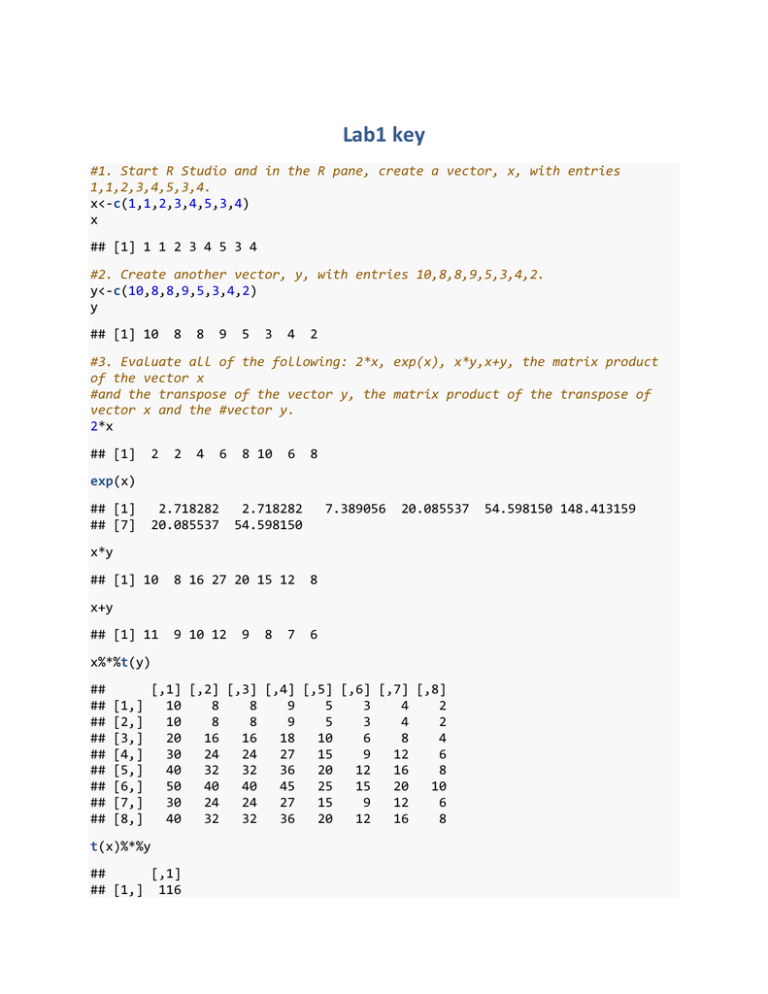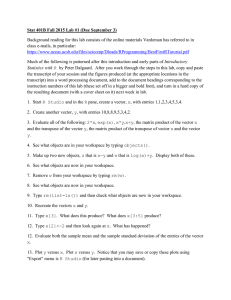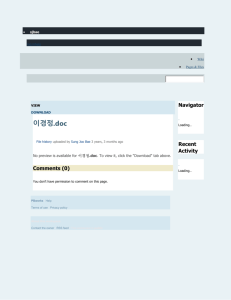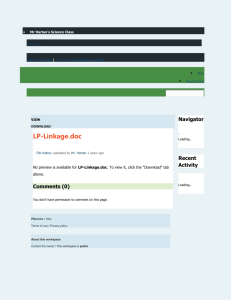Lab1 key
advertisement

Lab1 key #1. Start R Studio and in the R pane, create a vector, x, with entries 1,1,2,3,4,5,3,4. x<-c(1,1,2,3,4,5,3,4) x ## [1] 1 1 2 3 4 5 3 4 #2. Create another vector, y, with entries 10,8,8,9,5,3,4,2. y<-c(10,8,8,9,5,3,4,2) y ## [1] 10 8 8 9 5 3 4 2 #3. Evaluate all of the following: 2*x, exp(x), x*y,x+y, the matrix product of the vector x #and the transpose of the vector y, the matrix product of the transpose of vector x and the #vector y. 2*x ## [1] 2 2 4 6 8 10 6 8 exp(x) ## [1] ## [7] 2.718282 20.085537 2.718282 54.598150 7.389056 20.085537 x*y ## [1] 10 8 16 27 20 15 12 8 9 10 12 6 x+y ## [1] 11 9 8 7 x%*%t(y) ## ## ## ## ## ## ## ## ## [1,] [2,] [3,] [4,] [5,] [6,] [7,] [8,] [,1] [,2] [,3] [,4] [,5] [,6] [,7] [,8] 10 8 8 9 5 3 4 2 10 8 8 9 5 3 4 2 20 16 16 18 10 6 8 4 30 24 24 27 15 9 12 6 40 32 32 36 20 12 16 8 50 40 40 45 25 15 20 10 30 24 24 27 15 9 12 6 40 32 32 36 20 12 16 8 t(x)%*%y ## [,1] ## [1,] 116 54.598150 148.413159 #4. See what objects are in your workspace by typing objects(). objects() ## [1] "x" "y" #5. Make up two new objects, z that is x-y and w that is log(x)+y. Display both of these. z=x-y z ## [1] -9 -7 -6 -6 -1 2 -1 2 w=log(x)+y w ## [1] 10.000000 ## [8] 3.386294 8.000000 8.693147 10.098612 6.386294 4.609438 5.098612 #6. See what objects are now in your workspace. objects() ## [1] "w" "x" "y" "z" #7. Remove w from your workspace by typing rm(w). rm(w) #8. See what objects are now in your workspace. objects() ## [1] "x" "y" "z" #9. Type rm(list=ls()) and then check what objects are now in your workspace. rm(list=ls()) #10. Recreate the vectors x and y. x<-c(1,1,2,3,4,5,3,4) y<-c(10,8,8,9,5,3,4,2) #11. Type x[3]. What does this produce? What does x[3:5] produce? x[3] ## [1] 2 x[3:5] ## [1] 2 3 4 #12. Type x[2]<-2 and then look again at x. What has happened? x[2]<-2 x ## [1] 1 2 2 3 4 5 3 4 #12. Evaluate both the sample mean and the sample standard deviation of the entries of the vector #x. mean(x) ## [1] 3 sd(x) ## [1] 1.309307 #13. Plot y versus x. Plot x versus y. Notice that you may save or copy these plots using #"Export" menu is R Studio (for later pasting into a document). plot(x,y) plot(y,x) #14. Type the code below into a new R Script file in the upper left pane. Then highlight it #and run it. z<-cbind(x[1:4],y[5:8]) w<-rbind(x[1:4],y[5:8]) z ## ## ## ## ## [1,] [2,] [3,] [4,] [,1] [,2] 1 5 2 3 2 4 3 2 w ## [,1] [,2] [,3] [,4] ## [1,] 1 2 2 3 ## [2,] 5 3 4 2 z[2,1] ## [1] 2 w[2,1] ## [1] 5 #(cbind is binding together as columns and rbind is binding together as rows.) #15. Load the datasets package by checking it in the lower right R Studio pane. Then #click on the link to get to the documentation for the package. Examine the documentation of the #stackloss dataset. Type stackloss in the R pane. What appears? stackloss ## ## ## ## ## ## ## ## ## ## ## ## ## ## ## ## ## ## ## ## ## ## 1 2 3 4 5 6 7 8 9 10 11 12 13 14 15 16 17 18 19 20 21 Air.Flow Water.Temp Acid.Conc. stack.loss 80 27 89 42 80 27 88 37 75 25 90 37 62 24 87 28 62 22 87 18 62 23 87 18 62 24 93 19 62 24 93 20 58 23 87 15 58 18 80 14 58 18 89 14 58 17 88 13 58 18 82 11 58 19 93 12 50 18 89 8 50 18 86 7 50 19 72 8 50 19 79 8 50 20 80 9 56 20 82 15 70 20 91 15 #16. See what objects are now in your workspace. #(By the way, if you type Stackloss<-stackloss and now check to see what objects are in #your workspace, the new version of the dataset should appear in the list of objects. Apparently, #although the built-in version of the dataset is available to you, it is not formally loaded into #your workspace, but the assignment of it to a new name makes the newly named object a formal #part of the workspace.) objects() ## [1] "w" "x" "y" "z" #17. Type summary(stackloss). What is produced? What happens if you type #stackloss[3,3]? summary(stackloss) ## ## Air.Flow Min. :50.00 Water.Temp Min. :17.0 Acid.Conc. Min. :72.00 stack.loss Min. : 7.00 ## ## ## ## ## 1st Qu.:56.00 Median :58.00 Mean :60.43 3rd Qu.:62.00 Max. :80.00 1st Qu.:18.0 Median :20.0 Mean :21.1 3rd Qu.:24.0 Max. :27.0 1st Qu.:82.00 Median :87.00 Mean :86.29 3rd Qu.:89.00 Max. :93.00 1st Qu.:11.00 Median :15.00 Mean :17.52 3rd Qu.:19.00 Max. :42.00 stackloss[3,3] ## [1] 90 #18. Type stackloss[,1]. What do you get? stackloss[,1] ## [1] 80 80 75 62 62 62 62 62 58 58 58 58 58 58 50 50 50 50 50 56 70 #19. Make a histogram for stackloss[,1]. hist(stackloss[,1]) #20. Type pairs(stackloss). What is produced? pairs(stackloss)






